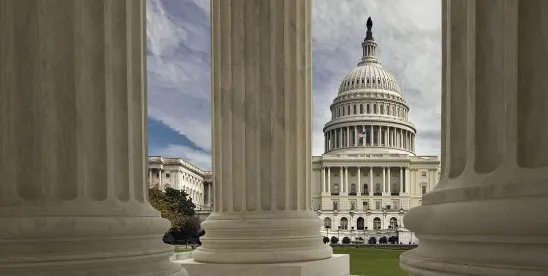The past year’s long wrangling between Republicans, Democrats, and the White House on permitting reform finally made progress this month when Congress enacted significant reforms to the National Environmental Policy Act (“NEPA”) as part of the legislation to increase the debt ceiling. Prior to this legislation, the core statutory framework of NEPA had remained relatively unchanged for 50 years. Building from Rep. Garrett Graves’ (R-LA., 6th Dist.) “Building United States Infrastructure through Limited Delays and Efficient Reviews” (“BUILDER”) Act of 2023, the permitting reform title of the Fiscal Responsibility Act of 2023 (“FRA” or “legislation”) tackles four key areas:
(1) reforming NEPA to make the federal environmental review process simpler and quicker;
(2) directing a study of the existing capacity of our transmission grid to reliably transfer electric energy between distinct regions and subsequent recommendations to improve interregional transfer capabilities within the grid;
(3) streamlining permitting for energy storage projects; and
(4) congressional ratification of the Mountain Valley Pipeline.
Several of the reforms to NEPA codify changes to the Council on Environmental Quality (“CEQ”) NEPA implementing regulations made during the Trump Administration.
While these provisions are intended to yield significant benefits for projects requiring federal approvals or funding, the actual impact will depend substantially on how the reforms are implemented, and there remains considerable interest in other aspects of permitting and siting reform making further legislative action likely.
Key NEPA Reforms
The FRA includes numerous changes to NEPA. We have highlighted several key changes here.
Narrowing the Scope of “Major Federal Action”
The term “major Federal action” is the trigger for requiring environmental review under NEPA – federal actions that qualify as a “major Federal action” must be considered under NEPA. The new legislation narrows the definition of what constitutes a “major Federal action” by limiting the term to actions that the lead agency deems are “subject to substantial Federal control and responsibility.” The legislation does not define this phrase, leaving substantial room for agency interpretation. Building on this general concept, the amendments codify the regulatory definition of a “major Federal action,” with modifications. As now defined, certain federal actions will be excluded from the scope of a major federal action, including:
-
non-federal actions (i.e., private or state actions) “with no or minimal Federal funding”;
-
non-federal actions (i.e., private or state actions) “with no or minimal Federal involvement where a Federal agency cannot control the outcome of the project”;
-
funding assistance consisting exclusively of general revenue sharing funds, where the federal agency does not have “compliance or enforcement responsibility” over the use of those funds;
-
“loans, loan guarantees, or other forms of financial assistance where a Federal agency does not exercise sufficient control and responsibility over the subsequent use of such financial assistance or the effect of the action”;
-
Small Business Act business loan guarantees under section 7(a) or (b) of the Small Business Act or title V of the Small Business Investment Act of 1958;
-
federal agency activities or decisions with effects located entirely outside of the jurisdiction of the United States; and
-
non-discretionary activities or decisions that are made in accordance with the agency’s statutory authority.
The meaning and application of these exclusions to specific actions will be subject to interpretation and likely litigation going forward. For example, what constitutes minimal funding—a threshold dollar amount or a percentage of the federal funding contribution in relation to overall project cost—is not clearly identified under the revisions. Resolution of this question will be critical to determining what actions are subject to NEPA review going forward. Given the recent dramatic increase in federal funding opportunities from the Inflation Reduction Act and Infrastructure Investment and Jobs Act, determining what actions are subject to NEPA review based on the level of federal funds involved is likely to become a more frequent and important question.
Scope of Review
When an agency action constitutes a “major Federal action,” the FRA also focuses and limits the scope of the NEPA review in two key ways.
First, the legislation modifies the statute’s existing, broad language requiring that “major Federal actions” significantly affecting the quality of the human environment include a detailed statement on the “environmental impact of the proposed action.” The revised language statutorily limits environmental review of environmental effects to those that are “reasonably foreseeable.” This change follows from a provision of the Trump Administration’s 2020 NEPA rule—later removed by the Biden Administration—which sought to eliminate long-used concepts of direct, indirect, and cumulative effects and instead focus on effects that are reasonably foreseeable and that have “a reasonably close causal relationship to” the proposed action or alternatives. Although the new statutory language does not go as far as the Trump Administration’s rule, which required a “close causal relationship,” it does follow the trend in case law to only require evaluation of reasonably foreseeable impacts. What project-specific impacts are “reasonably foreseeable” is still likely to be the subject of litigation.
Second, the FRA also makes changes regarding the alternatives analysis, often considered the heart of NEPA review. The legislation clarifies that agencies are to consider a “reasonable range” of alternatives to the proposed agency action, and that such alternatives must both be “technically and economically feasible” and “meet the purpose and need of the proposal.” This seems to codify long-standing guidance from CEQ contained in its 40 Most Asked Questions Concerning CEQ’s NEPA Regulations. In addition, it directs that, in assessing the no action alternative, agencies must include an analysis of any negative environmental impacts of not implementing the proposed action. Whether an agency has met its obligations under NEPA to consider “alternatives to the proposed action” is a frequent source of controversy and litigation, particularly for the authorization of large infrastructure and energy projects.
These changes should both help focus environmental reviews and reduce costs and delays associated with challenges to agencies’ alternative analyses and emphasize the importance of properly defining the “purpose and need” of a proposed action.
Data Standards and Requirements
The FRA includes several provisions related to data. First, it clarifies that in making a determination on the appropriate level of review (Environmental Impact Statement (“EIS”), Environmental Assessment (“EA”), or categorical exclusion), the lead agency can make use of any reliable data source—and that “new scientific or technical research [is not required] unless the new scientific or technical research is essential to a reasoned choice among alternatives, and the overall costs and time frame of obtaining it are not unreasonable.” It is unclear whether this will be applied beyond the determination of what level of review is required. This change has the potential to limit delays due to agencies undertaking or requesting additional studies from project proponents. What is deemed “essential” and what costs and timeframe are “not unreasonable,” however, remain undefined.
Second, the legislation requires that the action agency “ensure the professional integrity, including scientific integrity, of the discussion and analysis in an environmental document.” The practical implications and scope of this scientific integrity mandate are unclear—and is likely to be a subject of agency guidance and, potentially, future litigation.
Efficiency Measures
The FRA further codifies several less controversial changes from the Trump Administration 2020 NEPA rule, which the recent Biden rulemaking had left in place. These changes include expressly recognizing and establishing regulations for EAs. Additionally, these changes include setting page limits for EISs—150 pages generally and 300 pages for agency actions “of extraordinary complexity”—and EAs—75 pages—excluding citations and appendices. Additionally, the changes codify the regulatory presumptive deadlines for completion of NEPA reviews—two years for EISs and one year for EAs. The legislation goes beyond existing regulations by creating the right to judicial review when an agency fails to meet a deadline. Under the new legislation, if an agency misses the deadline, the delayed project’s sponsor may seek a court order requiring the agency to act as soon as practicable, which is not to exceed 90 days from the date on which the order was issued unless the court determines that additional time is needed to comply with applicable law.
Further, the legislation clarifies the role of the NEPA lead agency, specifying that the lead agency must develop a schedule, in cooperation with each cooperating agency, the applicant, and other appropriate entities, for the completion of the environmental review and any permit or authorization required to carry out the proposed agency action. This mirrors provisions previously adopted as part of Title 41 of the Fixing America’s Surface Transportation Act (“FAST-41”) in 2015, which has demonstrated success in requiring coordination and improving the permitting and authorization processes for certain large infrastructure projects. Although the FRA expressly contemplates extensions to the schedule, just having a schedule in place can be a helpful tool in the timely completion of NEPA reviews.
In addition, the legislation authorizes project applicants to hire independent consultants to prepare EISs and EAs, subject to the independent review of the lead agency. This provision can provide project applicants with a path to minimize delays caused by a lack of staff and resources at federal agencies.
Programmatic Reviews and Categorical Exclusions
The FRA also codifies the current agency practice of preparing and relying on programmatic environmental documents to streamline the review process for subsequent actions that implement the evaluated program. The legislation provides that programmatic review can be relied on for five years without additional review, and after five years if the agency reevaluates the analysis. Although this change promotes further use of programmatic reviews, the five-year period presumption and reevaluation process could present challenges in certain cases given the extensive resources and time required to undertake a programmatic review and tiered reviews.
The FRA also seeks to facilitate the use of categorical exclusions in the NEPA process by authorizing agencies to adopt a categorical exclusion established by another agency. The legislation lays out a process for consulting with the agency that established the exclusion to determine whether adoption is appropriate, notifying the public of the plan to use the categorical exclusion, and documenting adoption of the categorical exclusion. Though dependent upon agencies taking advantage of this new flexibility, this could have the effect of enabling some types of projects to forgo detailed environmental review.
Other Provisions
In addition to the NEPA reforms, the FRA includes several other important permitting provisions. The legislation seeks to streamline and accelerate permitting for “energy storage” projects by adding energy storage to the list of “covered projects” under FAST-41.
Additionally, the legislation provides a clear path for the completion of the much-delayed Mountain Valley Pipeline project. The legislation finds the timely completion of the project is in the national interest, and congressionally approves and ratifies the various federal authorizations required for the project. Further, the legislation bars judicial review of federal agency actions with respect to the project.
Finally, the legislation requires the North American Electric Reliability Corporation (“NERC," the entity responsible for setting reliability standards for the nation’s electric grid) to undertake a study within a year and a half on whether more transfer capacity is needed between existing transmission planning regions—including recommendations on measures to increase the amount of energy that can be reliably moved between the studied regions. The Federal Energy Regulatory Commission will thereafter have a year to seek and consider public comments on the study and file a report with Congress detailing any recommendations for statutory changes. This study provision was in lieu of a larger set of transmission-related actions that are of key interest to Democratic lawmakers that will be the subject of future legislative efforts.
Implications
Although the provisions in FRA are not a silver bullet to solve every NEPA woe experienced by project applicants, it is a significant step in the right direction. The codification of key concepts within the NEPA statute itself (rather than regulation, guidance, or case law) will have a durable, long-lasting impact on implementation of environmental reviews because it limits the regulation issuance/withdrawal cycle that we have witnessed with the recent administration changes.
Looking forward, we can expect a rulemaking by CEQ to align the existing regulations with the revised statutory language, as well as additional rulemakings by other agencies to harmonize their NEPA implementing regulations with the revised law. For the last year, we have awaited the Phase 2 NEPA rulemaking from CEQ, as explained in our previous alert. With this new legislation, it seems likely that CEQ will pause and further revise its proposed regulations to capture these new reforms before issuing additional regulations. We can also expect future guidance—and eventual litigation—on several ambiguous provisions in the new legislation as agencies begin to implement them.
While the intention behind the legislation is to speed and ease what has become a very lengthy, expensive, and perilous environmental review process—far exceeding the original intent of NEPA—whether these goals are achieved will depend on whether federal agencies embrace them or look for ways to interpret the reforms to continue “business as usual.”
For example, to meet the new timelines, it is possible that federal agencies will require applicants to provide all documentation needed for the environmental review before starting the clock. This approach would have the effect of undermining the statutory timeframes as well as the efficacy of the public engagement process. Similarly, while the legislation seeks to curtail the extent of the analysis through page limits, it is foreseeable that relatively short EISs and EAs could be weighed down with thousands of pages of analysis contained in the appendices.
It also remains to be seen how courts will interpret these reforms. The “hard look” standard developed by courts to evaluate the adequacy of environmental review documents may have the effect of ballooning the analyses again despite Congress’ intent to streamline the process.
Finally, while these reforms are substantial, Congress continues to discuss and debate additional reforms to address unresolved federal siting and permitting concerns—particularly with respect to energy infrastructure projects. Notably absent from the legislation was transmission permitting reform language of interest to Democratic lawmakers as well as provisions to support oil and gas leasing on federal lands and to facilitate the siting and permitting of mining projects to boost domestic supplies of critical minerals essential for existing and developing clean energy technologies.








 />i
/>i

